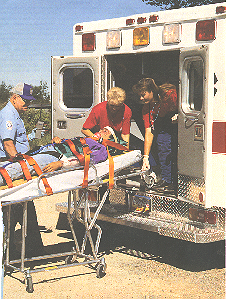Spinal cord injury after a fall
 A spinal cord injury can result from falls; thus a full assessment is critical after a fall to determine if there are injuries to the spinal cord. These injuries can be devastating.
A spinal cord injury can result from falls; thus a full assessment is critical after a fall to determine if there are injuries to the spinal cord. These injuries can be devastating.
Common types of spinal cord injury
The spine consists of 33 vertebrae: 7 cervical, 12 thoracic, 5 lumbar, 5 sacral and 4 coccygeal. The vertebral column provides the body’s basic structural support and also protects the spinal cord. The cervical spine is the most commonly injured part of the spinal column due to its exposed location and its inherent flexibility. The thoracic spine is rigidly flexed and a great amount of force is needed to damage this area of a healthy adult. For older adults with osteoporosis or bone disease, minor trauma may be sufficient to cause a compression fracture.
The thoracolumbar area is the second most commonly injured region. The spine changes from a kyphotic to a lordotic curve. Of all the thoracolumbar spine injuries, 90 percent of fractures occurred between T11-L4. Since the spinal canal is relatively wide at this level, thoracolumbar injuries rarely result in complete cord lesions.
The thoracic and lumbar areas have a three-column scheme. These columns are anterior, middle, and posterior. The location and extent of the fracture can determine the stability and instability of the spine.
Mechanisms of spinal cord injury
As a legal nurse consultant, it is helpful to understand what causes spinal cord injury.
Spinal column injury may result in spinal cord trauma through a number of mechanisms:
- Transection: Penetrating or massive blunt trauma resulting in spinal column injury that may tear part of the spinal cord; less severe trauma may have similar neurologic effects by displacing bony fragments into the spinal canal or through disk herniation.
- Compression: Wedge, or anterior, compression fractures account for 50 to 70 percent of all thoracolumbar fractures. Often simple wedge fractures cause no neurologic impairment.
- Burst fractures: The burst fractures account for approximately 14 percent of all thoracolumbar injuries. Compressive forces fracture the vertebral endplate then pressure the nucleus pulposa upon the vertebral body. The bony fragments can retropulse into the spinal canal. All burst fractures should be considered unstable because neurologic deficits are seen in 42 to 58 percent of patients.
- Contusion: Contusions of the spinal cord can occur from bony dislocation, subluxations, or fracture fragments.
- Vascular injury: Primary vascular damage to the spinal cord should be suspected when there is a discrepancy between a clinically apparent neurologic deficit and the known level of the spinal column injury.
If a patient is diagnosed with a spinal cord injury then the treatment plan includes an immediate surgical consultation. When there are no physicians with an expertise in orthopedics of the spine for consult available onsite, the standard of care requires the facility staff to arrange an immediate transfer to a hospital that can render care for the injury.
The treatment plan may include any of the following: surgical intervention, steroid administration, or application of a halo device (this may be used for the cervical or upper thoracic fractures).
From Barbara J. Levin BSN, RN, ONC, CMSRN, LNCC, Kelly Shanley MSN, RN, Elizabeth Hill, PhD, RN, PLNC, Falls and their Consequences, in Patricia Iyer, Barbara Levin, Kathleen Ashton and Victoria Powell, Nursing Malpractice, Fourth Edition.
Sharpen your skills for the analysis of a patient fall case. Sign up for an on demand online course lasting 6 hours on patient falls: Falls Course: The Impact of Head Injury. view it at your convenience through our digital downloads.

It could be devastating to suffer from severe injuries, there are several treatments and medications to take. We can’t determine the cost but it’s totally nerve wrecking. Good thing that technology nowadays is getting advanced to develop modern medical equipment to treat such kind of injury.